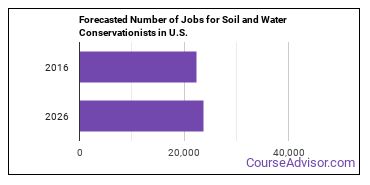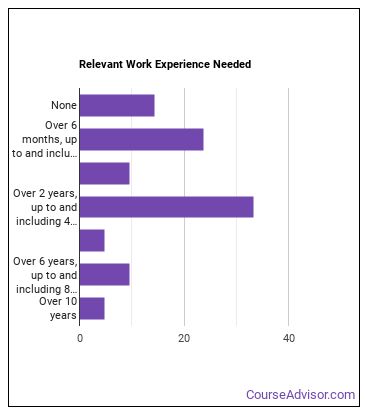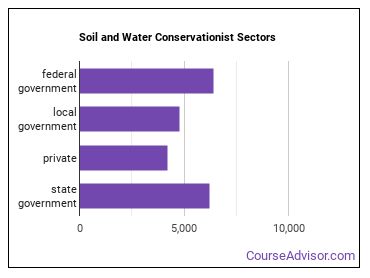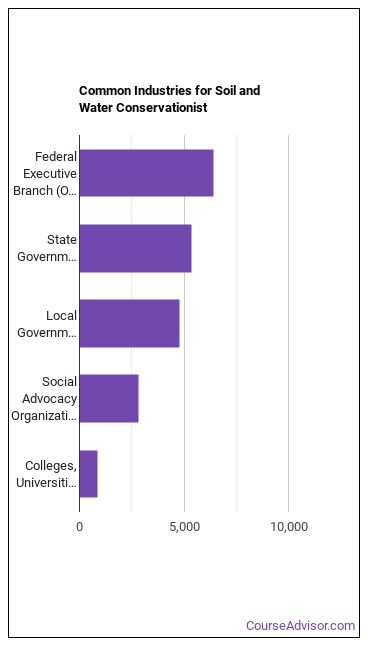What is a Soil and Water Conservationist?
Example of Soil and Water Conservationist Job Plan or develop coordinated practices for soil erosion control, soil or water conservation, or sound land use.
List of Soil and Water Conservationist Job Duties
- Enter local soil, water, or other environmental data into adaptive or Web-based decision tools to identify appropriate analyses or techniques.
- Analyze results of investigations to determine measures needed to maintain or restore proper soil management.
- Plan soil management or conservation practices, such as crop rotation, reforestation, permanent vegetation, contour plowing, or terracing, to maintain soil or conserve water.
- Develop or conduct environmental studies, such as plant material field trials or wildlife habitat impact studies.
- Evaluate or recommend geographic information systems (GIS) applications to address issues such as surface water quality, groundwater quality, ecological risk assessments, air quality, or environmental contamination.
- Develop water conservation or harvest plans, using weather information systems, irrigation information management systems, or other sources of daily evapotranspiration (ET) data.
Featured schools near , edit
Things a Soil and Water Conservationist Should Know How to Do
Below is a list of the skills most Soil and Water Conservationists say are important on the job.
Active Listening: Giving full attention to what other people are saying, taking time to understand the points being made, asking questions as appropriate, and not interrupting at inappropriate times.
Reading Comprehension: Understanding written sentences and paragraphs in work related documents.
Critical Thinking: Using logic and reasoning to identify the strengths and weaknesses of alternative solutions, conclusions or approaches to problems.
Writing: Communicating effectively in writing as appropriate for the needs of the audience.
Speaking: Talking to others to convey information effectively.
Complex Problem Solving: Identifying complex problems and reviewing related information to develop and evaluate options and implement solutions.
Types of Soil and Water Conservationist Jobs
- Water Conservation Specialist
- Department of Natural Resources Officer (DNR Officer)
- Range Conservationist
- Erosion Control Foreman
- Land Manager
Job Demand for Soil and Water Conservationists
In 2016, there was an estimated number of 22,300 jobs in the United States for Soil and Water Conservationist. New jobs are being produced at a rate of 6.3% which is above the national average. The Bureau of Labor Statistics predicts 1,400 new jobs for Soil and Water Conservationist by 2026. Due to new job openings and attrition, there will be an average of 2,000 job openings in this field each year.

The states with the most job growth for Soil and Water Conservationist are Colorado, New Hampshire, and Utah. Watch out if you plan on working in Rhode Island, New Mexico, or Maryland. These states have the worst job growth for this type of profession.
Soil and Water Conservationist Salary
The salary for Soil and Water Conservationists ranges between about $34,020 and $98,450 a year.

Soil and Water Conservationists who work in Connecticut, Alaska, or New Jersey, make the highest salaries.
How much do Soil and Water Conservationists make in each U.S. state?
| State | Annual Mean Salary |
|---|---|
| Alabama | $59,310 |
| Alaska | $93,390 |
| Arizona | $71,190 |
| Arkansas | $70,630 |
| California | $75,980 |
| Colorado | $71,170 |
| Connecticut | $87,710 |
| Delaware | $55,300 |
| Florida | $40,620 |
| Georgia | $69,390 |
| Hawaii | $68,360 |
| Idaho | $66,510 |
| Illinois | $63,840 |
| Indiana | $63,320 |
| Iowa | $56,820 |
| Kansas | $68,910 |
| Kentucky | $67,440 |
| Louisiana | $61,430 |
| Maine | $61,970 |
| Maryland | $79,070 |
| Massachusetts | $72,200 |
| Michigan | $63,460 |
| Minnesota | $72,650 |
| Mississippi | $54,870 |
| Missouri | $57,580 |
| Montana | $64,480 |
| Nebraska | $65,300 |
| Nevada | $61,670 |
| New Hampshire | $72,160 |
| New Jersey | $85,360 |
| New Mexico | $68,710 |
| North Carolina | $61,780 |
| North Dakota | $64,900 |
| Ohio | $55,550 |
| Oklahoma | $64,330 |
| Oregon | $76,790 |
| Pennsylvania | $55,200 |
| South Carolina | $56,220 |
| South Dakota | $62,390 |
| Tennessee | $68,440 |
| Texas | $57,990 |
| Utah | $63,720 |
| Vermont | $55,150 |
| Virginia | $75,370 |
| Washington | $65,120 |
| West Virginia | $50,210 |
| Wisconsin | $65,610 |
| Wyoming | $71,180 |
What Tools & Technology do Soil and Water Conservationists Use?
Below is a list of the types of tools and technologies that Soil and Water Conservationists may use on a daily basis:
- Microsoft Excel
- Microsoft Word
- Microsoft Office
- Microsoft PowerPoint
- Microsoft Outlook
- Web browser software
- Microsoft Access
- Email software
- Word processing software
- Microsoft Windows
- Autodesk AutoCAD
- Adobe Systems Adobe Acrobat
- Geographic information system GIS software
- ESRI ArcView
- Microsoft Active Server Pages ASP
- ESRI ArcInfo
- ESRI ArcGIS software
- Autodesk Maya
- Clover Technology GALENA
- State Soil Geographic STATSGO Database
How do I Become a Soil and Water Conservationist?
Learn what Soil and Water Conservationist education requirements there are.

What work experience do I need to become a Soil and Water Conservationist?

Who Employs Soil and Water Conservationists?

The table below shows some of the most common industries where those employed in this career field work.

You May Also Be Interested In…
Those thinking about becoming a Soil and Water Conservationist might also be interested in the following careers:
Are you already one of the many Soil and Water Conservationist in the United States? If you’re thinking about changing careers, these fields are worth exploring:
- Farm and Home Management Advisors
- Civil Engineers
- Nursery and Greenhouse Managers
- Food Scientists and Technologists
- Natural Sciences Managers
- Architects, Except Landscape and Naval
References:
Image Credit: Lynn Betts via Photo by Lynn Betts, USDA Natural Resources Conservation Service
More about our data sources and methodologies.
Featured Schools
 Request Info
Request Info
|
Southern New Hampshire University You have goals. Southern New Hampshire University can help you get there. Whether you need a bachelor's degree to get into a career or want a master's degree to move up in your current career, SNHU has an online program for you. Find your degree from over 200 online programs. Learn More > |
